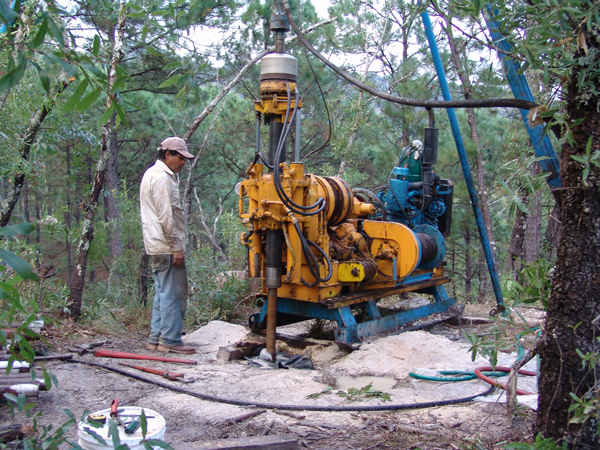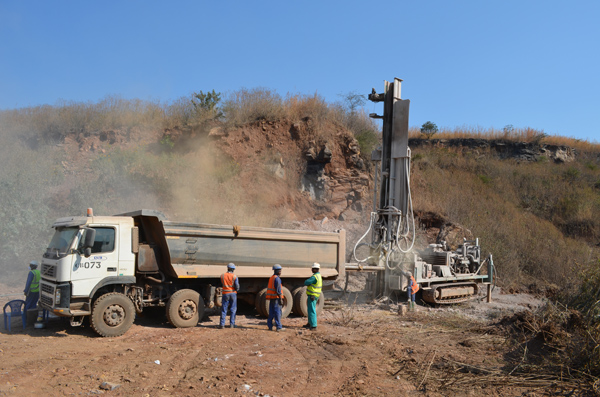Geological Exploration of Industrial Minerals
While precious and base metals deposits are usually evaluated according to the weight of the minable elements to be recuperated per ton of ore, industrial mineral deposits are evaluated according to the end user’s product specifications. For example, the characteristics of a calcium carbonate deposit are evaluated according to the end-user’s application, including but not limited to CaO, MgO, heavy metal contents, whiteness, brightness and other physical and chemical properties. Some clays are evaluated according to particle size distribution, iron content and capacity to de-flocculate and susceptibility to forming a ceramic paste.
Industrial minerals play an important role in construction and infrastructure as a source of raw materials for manufacturing many construction materials. Applications may vary from cement, lime, glass and ceramics to paint fillers and plastics. Some industrial minerals are used for manufacturing cosmetics and pharmaceuticals.
There are certain factors that should be considered in the evaluation of an industrial minerals deposit. A very important one is the cost of logistics. Most precious metals deposits justify the construction of expensive access roads to haul the mineral out of remote areas. The transportation of industrial minerals from remote locations is unaffordable. Industrial minerals are usually conveyed for relatively short distances to be processed; however, once the end product is developed, it can be transported longer distances where there is demand for it and it can be delivered at a competitive price. Another factor to be considered in the evaluation of an industrial minerals deposit is the policies of the region and country where the deposit is located. Politics and social conditions also play an important role.
In the long term, markets evolve and change depending on the state of development of the area or country. A developing country or region might need considerable amounts of cement, lime and aggregates while more developed regions may have greater need for furniture, public transportation, cars, computers, pharmaceutical products, paints, cosmetics and other products. Therefore, an analysis of the market where a specific industrial mineral intends to be sold is an important priority.
Regardless the type of industrial mineral, the characterization of the deposit is essential. Giving consideration to the end user, it is paramount to understand the mineral distribution in the deposit. Even when characterization of a deposit seems to be a simple process, mistakes are made due to lack of understanding of the process. The following paragraphs provide guidelines necessary to evaluate an industrial minerals deposit.

Figure 1 Core drilling in a remote area in Mexico. The equipment had to be kept as simple as possible due to the difficulties of moving it through the forest in an area without access roads. Construction of access roads was not justified at this evaluation stage. The deposit is a granitic rock being evaluated as a source of feldspar for the glass and ceramic industry.
Geological Mapping
Evaluation of mineral deposits should always start with a reliable geological map and a set of geological-structural sections. The set of geological-structural sections represents the first geological model, which can be created using any of the 3D modeling software available in the market. Geological models can be simple or sophisticated, depending on the structural setting and mineralization. The variables required by the end user will determine whether the model should integrate variations on the parameters of interest. The ideal industrial mineral deposit does not present many geological or structural changes; actually, the intent is to search for homogeneous materials which will produce an industrial mineral of high quality and consistency. Surface sampling should be conducted to identify the variation of different materialization parameters.
Characterization of the Mineral Deposit
The geological exploration should consider the variations associated to fractures, faults, bedding in the case of sedimentary deposits, and the variation of textures in the rock. Raw materials applicable for one industry may not necessarily comply with the requirements of other industries. For example, a white calcium carbonate may be used as filler for paints, but it will not necessarily comply with the specifications used in pharmaceuticals. The characterization of the deposit should be done according to the target industry. A deposit used for a specific application should be re-evaluated if the market specifications change or if the producer wishes to market to another end user with different requirements.
Eventually, the deposit will be drilled and the type of drilling required should be specified. There are two types of drilling: Core drilling and reverse circulation drilling. Core drilling provides more reliable information but it’s more expensive. Reverse Circulation (RC) is less expensive and faster, but some of the deposit characteristics may not be identifiable. For a true characterization of a deposit, a grid of boreholes using a core drilling rig may be necessary. RC drilling can be used later to obtain complementary information between core boreholes.
Data Organization and Data Management
There is a handful of software to organize borehole and complementary data. Borehole data may include borehole ID, XYZ location, total depth, orientation, inclination, lithologies, structural information, geochemical data, etc. Non-borehole data includes air photos, satellite images, contour lines, surface geochemistry, hydrology and geophysics.
The final objective of 3D modeling software is to visualize the deposit from any angle, which provides a better understanding of the deposit and facilitates the preparation of the mining plan. There are several ways to visualize the information. Geological cross-sections show the variations in the concentration of geochemical data in different directions. Horizontal sections at different elevations showing analytical results are commonly used for analysis. There is a wide range of visualization diagrams according to the type of data required to develop the mining plan.

Figure 2 RC drilling in an area with good access roads in the Democratic Republic of Congo. Limestone deposit being evaluated for the production of lime and cement. Note the size of the equipment.
Mining Plan
Industrial minerals are usually inexpensive compared to base or precious metals, which may be mined underground and under the water table level. Industrial minerals usually cannot afford to be mined underground and are rarely mined under the water table. Some exceptions are when mining some clays or sands using dredges. Industrial minerals are usually mined in open pits and the presence or lack of overburden usually plays an important role in the cost of the end product.
Transportation between the mine and processing plant is also important. The lower the yield, the higher the cost impact of transportation. It is important to get rid of overburden and rejects as close to the quarry as possible to avoid the transportation cost of non-saleable materials.
The movement of material and use of equipment in the quarry will influence the final mining cost. The equipment used in the quarry should be highly efficient to keep mining costs at a minimum, but the skills of the heavy equipment operators are also important. The decision between front-end loaders or excavators (tires vs. tracks), type of hauling trucks, size of loading buckets are all as important factors as well as the efficiency of different brands of heavy equipment which might work better in the country or region where the project is located considering service and replacement parts.
Location of the Processing Plant
The best location for the processing plant is adjacent the quarry, but this is not always possible. There are many parameters that have to be taken into consideration, for example availability of land, water, power source, labor, access, environmental issues, etc.
CONCLUSIONS
The exploration of industrial minerals should be based on the demand of the end product. Industrial minerals cannot afford to be hauled long distances. They are dependent on the specifications of the end user, so the location of industrial minerals deposits is tied to developed areas with appropriate infrastructure and access roads. Every deposit is different and therefore all factors should be considered. Cultural factors, construction methods, and the economy of the region are important considerations.
This article was contributed by Mario Mansilla, Senior Consultant/Geology at PEC Consulting Group. He has 30 years experience in the mining industry, mostly in industrial minerals. He has done evaluation of mineral deposits, and technical and geological studies for projects around the globe. He has a BS in Geology from the Universidad Autónoma de San Luis Potosi, México; an MS degree in Geology from Westfälishe-Wilhelms Universität Münster, Germany, and Postgraduate degree in Environmental Analysis, Instituto Tecnológico de Estudios Superiores de Monterrey.

Leave a Reply
Want to join the discussion?Feel free to contribute!